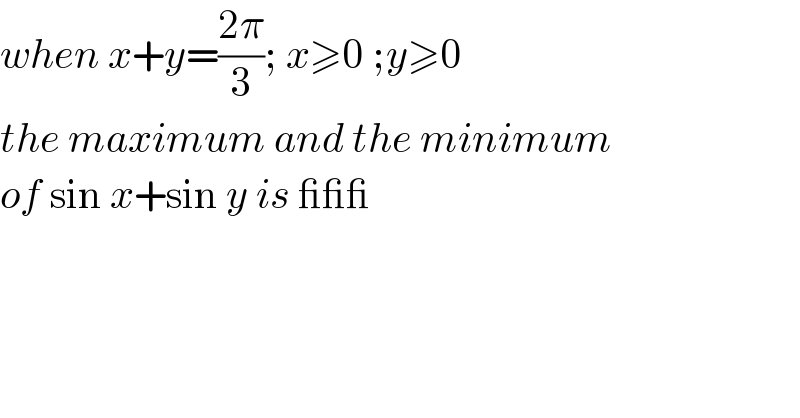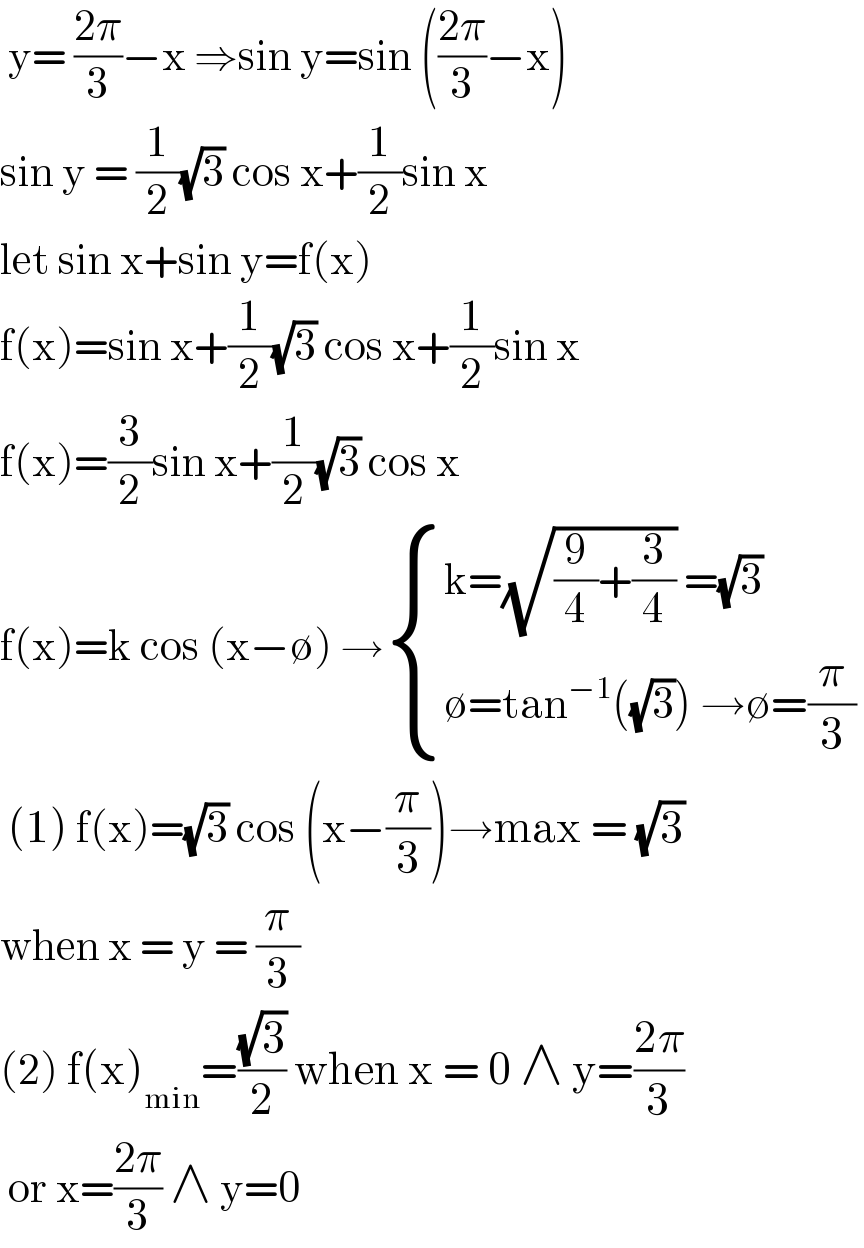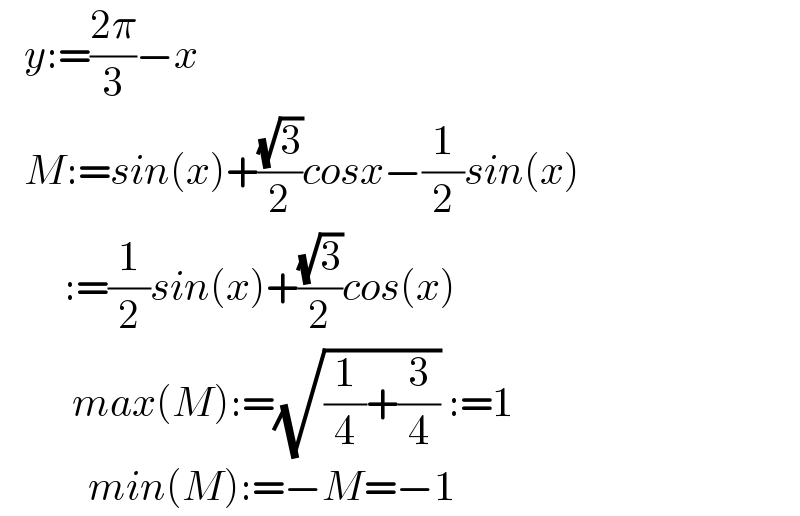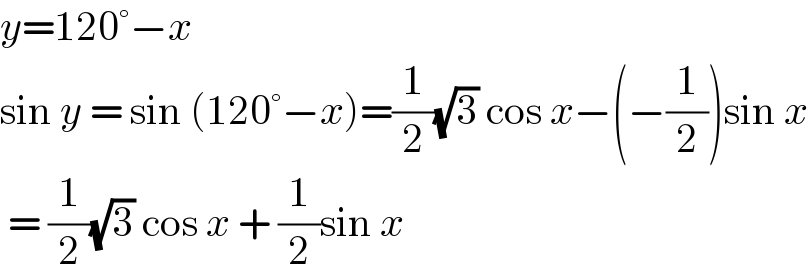Question Number 143450 by bramlexs22 last updated on 14/Jun/21

$${when}\:{x}+{y}=\frac{\mathrm{2}\pi}{\mathrm{3}};\:{x}\geqslant\mathrm{0}\:;{y}\geqslant\mathrm{0} \\ $$$${the}\:{maximum}\:{and}\:{the}\:{minimum} \\ $$$${of}\:\mathrm{sin}\:{x}+\mathrm{sin}\:{y}\:{is}\:\_\_\_\: \\ $$
Answered by EDWIN88 last updated on 16/Jun/21

$$\:\mathrm{y}=\:\frac{\mathrm{2}\pi}{\mathrm{3}}−\mathrm{x}\:\Rightarrow\mathrm{sin}\:\mathrm{y}=\mathrm{sin}\:\left(\frac{\mathrm{2}\pi}{\mathrm{3}}−\mathrm{x}\right) \\ $$$$\mathrm{sin}\:\mathrm{y}\:=\:\frac{\mathrm{1}}{\mathrm{2}}\sqrt{\mathrm{3}}\:\mathrm{cos}\:\mathrm{x}+\frac{\mathrm{1}}{\mathrm{2}}\mathrm{sin}\:\mathrm{x} \\ $$$$\mathrm{let}\:\mathrm{sin}\:\mathrm{x}+\mathrm{sin}\:\mathrm{y}=\mathrm{f}\left(\mathrm{x}\right) \\ $$$$\mathrm{f}\left(\mathrm{x}\right)=\mathrm{sin}\:\mathrm{x}+\frac{\mathrm{1}}{\mathrm{2}}\sqrt{\mathrm{3}}\:\mathrm{cos}\:\mathrm{x}+\frac{\mathrm{1}}{\mathrm{2}}\mathrm{sin}\:\mathrm{x} \\ $$$$\mathrm{f}\left(\mathrm{x}\right)=\frac{\mathrm{3}}{\mathrm{2}}\mathrm{sin}\:\mathrm{x}+\frac{\mathrm{1}}{\mathrm{2}}\sqrt{\mathrm{3}}\:\mathrm{cos}\:\mathrm{x}\: \\ $$$$\mathrm{f}\left(\mathrm{x}\right)=\mathrm{k}\:\mathrm{cos}\:\left(\mathrm{x}−\emptyset\right)\:\rightarrow\begin{cases}{\mathrm{k}=\sqrt{\frac{\mathrm{9}}{\mathrm{4}}+\frac{\mathrm{3}}{\mathrm{4}}}\:=\sqrt{\mathrm{3}}}\\{\emptyset=\mathrm{tan}^{−\mathrm{1}} \left(\sqrt{\mathrm{3}}\right)\:\rightarrow\emptyset=\frac{\pi}{\mathrm{3}}\:}\end{cases} \\ $$$$\:\left(\mathrm{1}\right)\:\mathrm{f}\left(\mathrm{x}\right)=\sqrt{\mathrm{3}}\:\mathrm{cos}\:\left(\mathrm{x}−\frac{\pi}{\mathrm{3}}\right)\rightarrow\mathrm{max}\:=\:\sqrt{\mathrm{3}}\: \\ $$$$\mathrm{when}\:\mathrm{x}\:=\:\mathrm{y}\:=\:\frac{\pi}{\mathrm{3}} \\ $$$$\left(\mathrm{2}\right)\:\mathrm{f}\left(\mathrm{x}\right)_{\mathrm{min}} =\frac{\sqrt{\mathrm{3}}}{\mathrm{2}}\:\mathrm{when}\:\mathrm{x}\:=\:\mathrm{0}\:\wedge\:\mathrm{y}=\frac{\mathrm{2}\pi}{\mathrm{3}} \\ $$$$\:\mathrm{or}\:\mathrm{x}=\frac{\mathrm{2}\pi}{\mathrm{3}}\:\wedge\:\mathrm{y}=\mathrm{0} \\ $$
Answered by mnjuly1970 last updated on 14/Jun/21

$$\:\:\:{y}:=\frac{\mathrm{2}\pi}{\mathrm{3}}−{x} \\ $$$$\:\:\:{M}:={sin}\left({x}\right)+\frac{\sqrt{\mathrm{3}}}{\mathrm{2}}{cosx}−\frac{\mathrm{1}}{\mathrm{2}}{sin}\left({x}\right) \\ $$$$\:\:\:\:\:\:\:\::=\frac{\mathrm{1}}{\mathrm{2}}{sin}\left({x}\right)+\frac{\sqrt{\mathrm{3}}}{\mathrm{2}}{cos}\left({x}\right) \\ $$$$\:\:\:\:\:\:\:\:\:{max}\left({M}\right):=\sqrt{\frac{\mathrm{1}}{\mathrm{4}}+\frac{\mathrm{3}}{\mathrm{4}}}\::=\mathrm{1} \\ $$$$\:\:\:\:\:\:\:\:\:\:\:{min}\left({M}\right):=−{M}=−\mathrm{1} \\ $$
Commented by bramlexs22 last updated on 15/Jun/21

$${y}=\mathrm{120}°−{x} \\ $$$$\mathrm{sin}\:{y}\:=\:\mathrm{sin}\:\left(\mathrm{120}°−{x}\right)=\frac{\mathrm{1}}{\mathrm{2}}\sqrt{\mathrm{3}}\:\mathrm{cos}\:{x}−\left(−\frac{\mathrm{1}}{\mathrm{2}}\right)\mathrm{sin}\:{x} \\ $$$$\:=\:\frac{\mathrm{1}}{\mathrm{2}}\sqrt{\mathrm{3}}\:\mathrm{cos}\:{x}\:+\:\frac{\mathrm{1}}{\mathrm{2}}\mathrm{sin}\:{x}\: \\ $$
